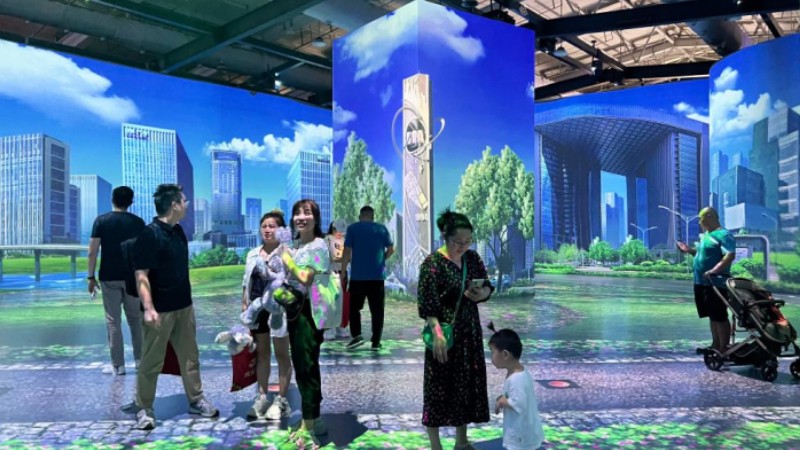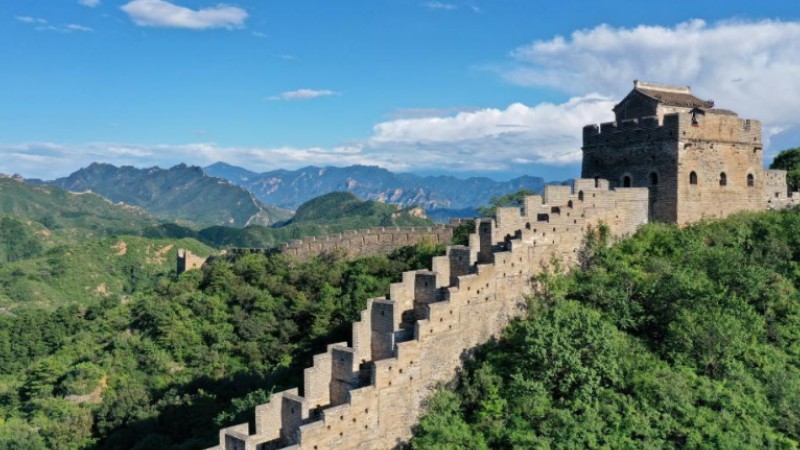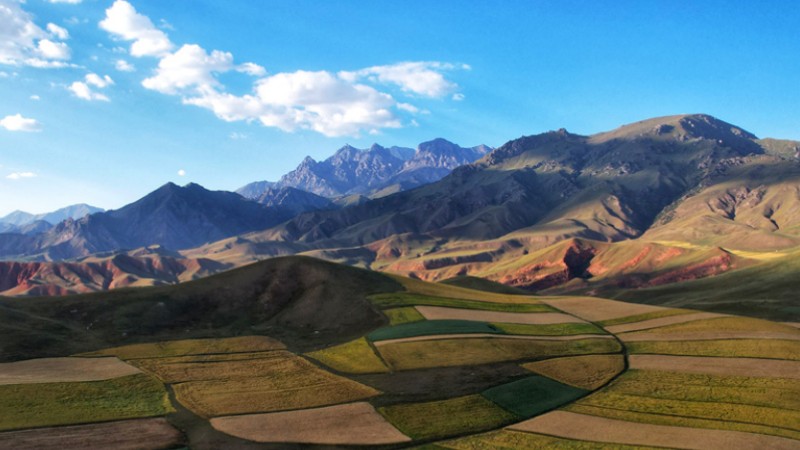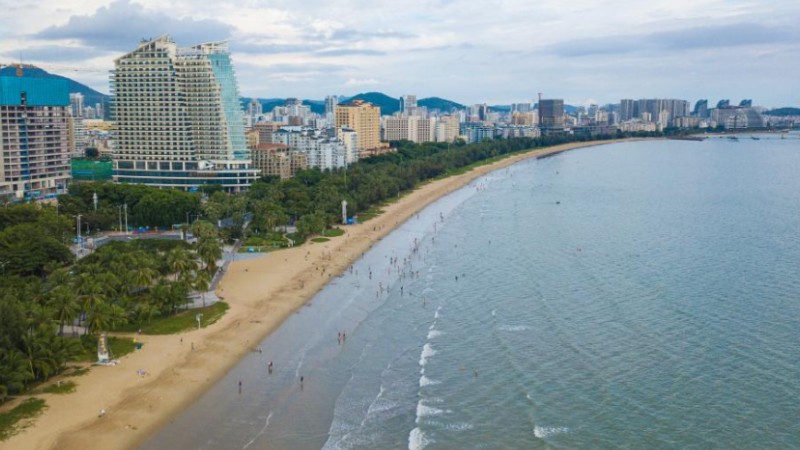Findings shed light on capital's impressive past

An aerial view of the Jin Dynasty Imperial Mausoleums in Beijing's Fangshan district. YANG ZHIGUO/FOR CHINA DAILY
City dating back 800 years unearthed near new business area
The Lize Financial Business District in southwestern Beijing is home to numerous glass-walled high-rises, which stand as proud sentinels keeping watch over this new landmark in the Chinese capital.
The district only opened at the end of 2021, but under the ground nearby lie the ancient city walls and moat of Zhongdu, which in 1153 became the capital of the Jin Dynasty (1115-1234). It was the first time that Beijing had been the capital city during a Chinese dynasty.
More than 2,900 square meters of the Zhongdu city wall ruins were unearthed in 2019 and 2020, and a section of the western wall, which is 24 meters wide at its thickest point, is the best preserved.
The old city ruins, together with the kitchen tools and ornaments used by residents in ancient times, have been preserved at the site or in museums.
An exhibition commemorating the 870th anniversary of Beijing becoming the capital, which opened at the Beijing Archaeological Site Museum on June 10, runs until Sept 30.
A total of 187 cultural relics from six Jin Dynasty sites are exhibited at the museum, including architectural pieces from the Jinzhongdu ruins, porcelain, gold and silverware, jade, pottery and murals reflecting daily life.
The imperial palace, lanes and hutong, or alleyways, in which residents lived, as well as city gates, moats, streets and the tombs of imperial family members, are depicted in the form of objects and other traces left by the Jurchen and Han people who lived in Zhongdu.
Well-known scenic spots in Beijing, such as Yinshan Pagoda Forest in Changping district and Lugou Bridge in Fengtai, which were built when Zhongdu was capital of the Jin Dynasty, are also highlighted at the exhibition.
Ding Lina, a researcher at the Beijing Archaeological Research Institute, who focuses on studies of the Liao (907-1125), Jin and Yuan (1271-1368) dynasties, said, "We can observe the communication and integration between the Jurchen and Han people through cultural aspects of the tomb artifacts from the Jin Dynasty.
"For example, at a Han ethnic burial site, we discovered not only the Buddhist copper ornaments that Han people believe in, but also a small copper figurine, which is generally thought to represent a ritual object used in the Jurchen people's primitive shamanistic religion.
"In the tombs, we also found that ethnic cultural integration between the Han and Jurchen people was a two-way process, with the two ethnicities influencing and promoting each other."
Ding said the Jin Dynasty mausoleum system, in which imperial tombs were built on mountains near the capital, followed the shape and structure of those from the Tang (618-907) and Song (960-1279) dynasties.
The layout of the mausoleums is also evidence of the merging of Jurchen and Han culture, Ding said.
She added that due to the relocation of the capital and imperial mausoleums, a large number of Jurchen nobles and warriors, along with people from minority groups such as the Bohai and Khitan, came to Zhongdu to promote cultural exchanges among different ethnic groups.
In the 120-year history of the Jin Dynasty, its capital city was relocated twice. When Wanyan Liang, the fourth Jin Dynasty emperor, ascended the throne, he moved the dynastic capital to Yanjing (present-day Beijing) in 1153, from the northeastern city of Shangjing (now Harbin, capital of Heilongjiang province). Zhongdu was also chosen by the emperor as the dynastic capital due to its abundant resources and well-connected transportation links.
Before the Jin Dynasty, most capitals of ancient Chinese dynasties were located in Luoyang, Henan province, or Xi'an, Shaanxi province. Earlier than this, Erlitou and Yinxu in Henan were capitals during the Xia and Shang dynasties (c. 21st century-11th century BC).
The book Current Affairs of Beijing, written during the reign of Emperor Qianlong (1711-99) during the Qing Dynasty (1644-1911) states: "Starting from ancient times, emperors have established their capitals in many places (across China). For a long time, only the plain in central Shaanxi was favored by them as a capital. Now, only Yanjing is comparable, and has been considered a capital city for an extended period."
Beijing, initially founded as Ji, capital of the Yan state during the Western Zhou Dynasty (c. 11th century-771BC), was only a border town in the northern region of China in the Tang Dynasty and the southern capital during the Liao Dynasty. It became known as Zhongdu in the Jin Dynasty, and acted as the nation's political and cultural center.
Kublai Khan, founder of the Yuan Dynasty, renamed Zhongdu as Dadu ("great capital") and declared it the national capital.
In 1403, Zhu Di, also known as Emperor Yongle, the third emperor of the Ming Dynasty (1368-1644), decided to relocate the capital from Nanjing to Beiping, and renamed the latter Beijing.
In 1644, Emperor Shunzhi, the first emperor of the Qing Dynasty to enter Beijing, moved the capital from Shengjing (now Shenyang in Liaoning province) to Beijing.
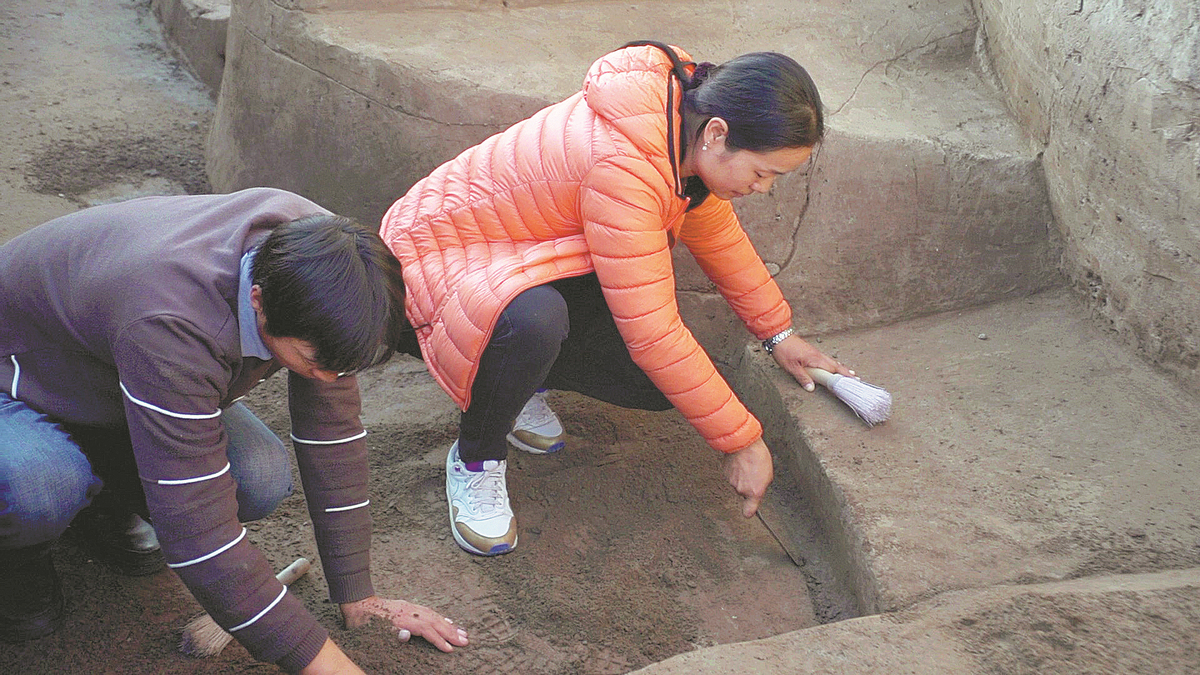
Ding Lina (right), a researcher at the Beijing Archaeological Research Institute, takes part in an excavation at the Zhongdu site during the winter in 2019. CHINA DAILY
Turning point
Liu Naitao, deputy director of the Beijing Archaeological Site Museum and co-curator of the new exhibition, said, "The establishment of Zhongdu during the Jin Dynasty was not only a new stage in the development of the ancient dynasty, but also a new era in the history of Beijing's urban development, marking a turning point in the history of Chinese capital cities.
"The overall layout of Zhongdu is similar to that of Bianliang (present-day Kaifeng city in Henan), which was capital of the Northern Song Dynasty (960-1127) and influenced the construction of capitals in the Yuan, Ming and Qing dynasties.
"After Zhongdu was built and became capital in the Jin Dynasty, the principle of following a central axis to build a capital city took shape. Later, Beijing expanded along the central axis and followed the layout formulated for Zhongdu."
Liu said Zhongdu comprised the imperial city, the palace city and the outer city. Areas housing pottery stores, ironware shops, pastry houses and residents' homes were scattered along the central North-South axis, which stretched out from the imperial palace.
As the political, economic and cultural center of the Jin Dynasty, the ruling class and people from different social strata and ethnic backgrounds gathered in Zhongdu. It also attracted a huge number of businesses and artisans.
The mix of residents and businesses helped Zhongdu absorb and integrate the characteristics of Han culture with nomadic traditions — promoting the city's prosperity and development.
One such example is the living quarters. Liu said the enclosed communities of the Liao Dynasty were replaced by a system in which neighborhoods were open during the day, along with commercial streets and alleyways.
"During the early Tang Dynasty and the Liao Dynasty, living quarters in Beijing were enclosed on all four sides, with a square in the center of the neighborhood," Liu said. "The living quarters resembled modern communities and were surrounded by four walls and one gate for each main direction. The gates opened in the morning and closed at night."
The new residential quarters established in Zhongdu were different from the earlier ones, he said, adding that archaeological excavations revealed the demolition of walls and the disappearance of gates. Open streets and alleys were integrated with residential communities. As a result, the city's economy and businesses flourished.
Records show that during its most prosperous period, Zhongdu had 62 enclosed residential communities, each occupying about 500 square meters. These communities opened at about 4 am or 5 am and closed at 6 pm or 7 pm.
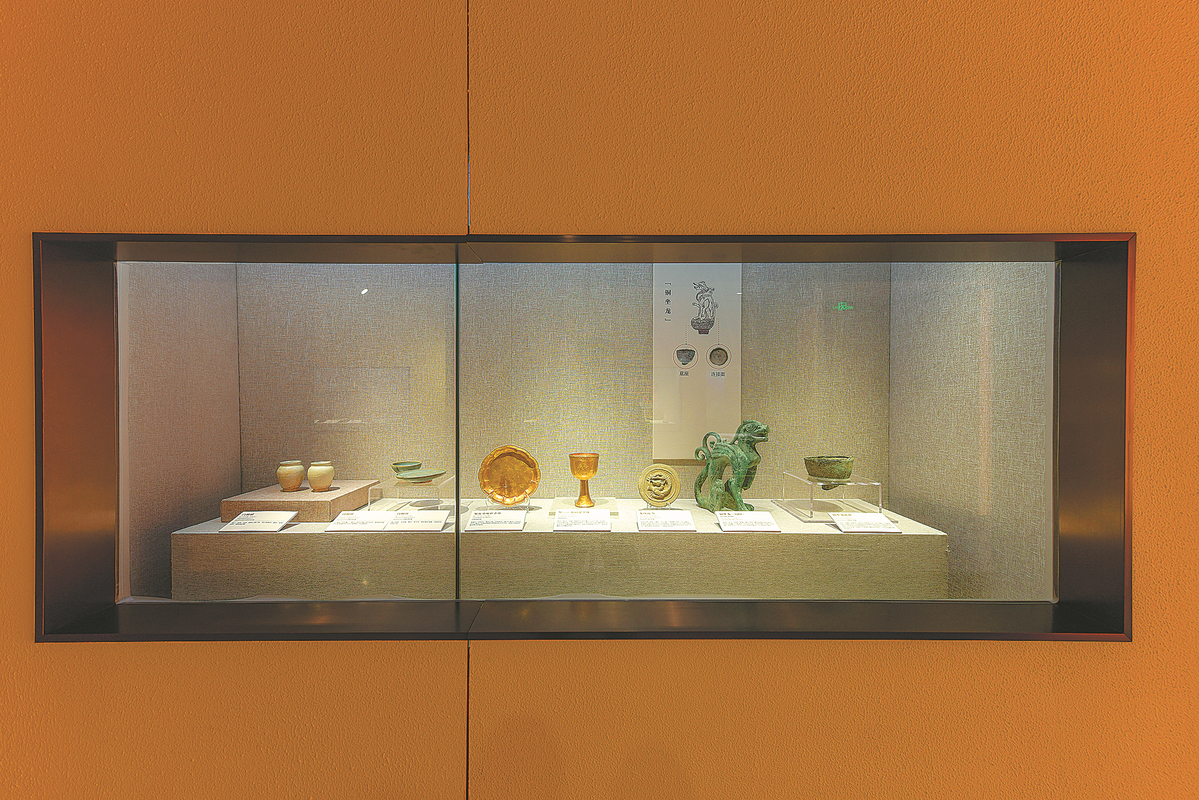
Objects from the Jin Dynasty (1115-1243) are displayed in an ongoing exhibition at the Beijing Archaeological Site Museum. YANG ZHIGUO/FOR CHINA DAILY
Defensive system
Jin Dynasty Emperor Wanyan Liang, who decided to relocate the capital, set up a complete defensive system around Zhongdu to prevent potential attacks from northern Mongolian tribes. The Jin Dynasty was one of the few established by an ethnic minority.
Ding, from the Beijing Archaeological Research Institute, said that before the Tang Dynasty, emphasis on the defensive capabilities of the capital was placed on high walls and deep moats. However, over time, as more artillery was used in military battles, the city wall needed to be improved.
"The city wall was about 16 to 18 meters high and the moat was 66 meters wide. The wall, the moat and other facilities such as a fortified tower shaped like a horse's head constituted the defensive works of Zhongdu," she said.
At the start of the Jurchen regime, the rulers faced resistance and suppression from the nomadic Khitan people. Without sturdy city walls, the Jurchen population could have been wiped out by this strong northern tribe.
Later, the Jurchen people faced threats from the Mongols.
"Outer defense is of paramount importance to an ancient city. Once the outer city walls are breached, defense of the inner city is basically rendered useless," Ding said.
She added that at various periods, all Jin Dynasty rulers introduced policies to encourage farming.
"The emphasis they placed on land and agriculture brought stability, and the Jurchen people, who relied on fishing and hunting for a living, started to settle down, which deepened their dependence on cities," she said.
Although the Zhongdu city gates have not yet been discovered, finding the moat and tower shaped like a horse's head are strong evidence that Zhongdu possessed a complete defensive system as a capital city, Ding said.
|<
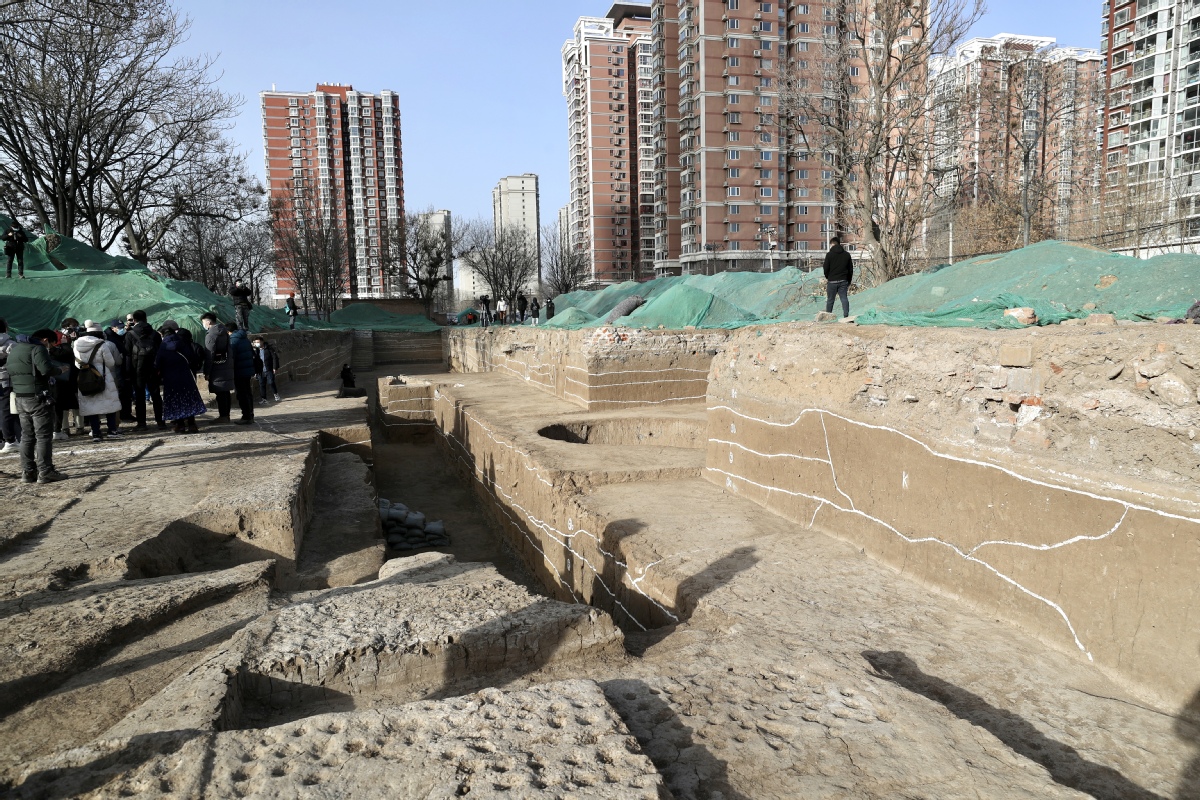
The archaeological excavation site of Zhongdu of Jin Dynasty (1115-1234) at Fengtai district in Beijing. ZOU HONG/CHINA DAILY
Past and present
Zhongdu, which covered 25 sq km, was the capital for 62 years in the Jin Dynasty. The earliest central axis of Beijing was also that of Zhongdu, even though it is located in the southwest of present-day Beijing.
"When Wanyan Liang first moved the capital to Zhongdu, the city's population was relatively small," Ding said. To increase the population and promote the city's development, a 10-year labor tax exemption policy was introduced to attract more residents to settle in Zhongdu, she added.
"Zhongdu was a city full of mystery, so when I knew that I had the opportunity to excavate the ancient ruins at the end of 2019, I felt privileged and excited," she said.
"Under our feet is a capital city with a history of more than 800 years. Being one of the first to discover how these buildings were constructed made me realize I had a great responsibility and obligation to conduct archaeological work for the public."
In winter 2020, the archaeological excavation team led by Ding discovered a Jin Dynasty crossroads under the Lize Soho building. Ding said that by coincidence, there is an interchange between the Beijing Subway Line 14 and Line 16 at the location where the crossroads was found.
The Beijing municipal government said bidding to construct a themed city park archaeological site — Zhongdu of Jin Dynasty — opened in April. Covering 150,000 sq m, the park will be located in and around the Lize commercial area in Fengtai. Construction is expected to be completed in a year.
Venues for cultural exhibitions and public services will be provided, as well as an outdoor display area that highlights the history of Zhongdu, city officials said.
TIMELINE
1952: Architectural remains and Jin Dynasty (1115-1234) tombs are discovered near Taoranting Park in Xicheng district, Beijing.
1958: Archaeologists survey the remains of the Zhongdu city wall and conduct a comprehensive survey of the site. They also draw a preliminary sketch of the Zhongdu city restoration.
1990: The Zhongdu water gate is discovered at a community in Fengtai district, Beijing. The remains consist of north-south wooden and stone structures, with the gate built across the city wall. Water flowed north to south through a tunnel, entering the southern moat in Zhongdu.
1990: The Zhongdu palace area ruins are discovered, with specific locations of the main palace and other buildings identified.
Photos
Related Stories
- Ceremony held to honor legendary ancestor of Yandi in Shaanxi
- Rock paintings found in NW China's Qinghai
- History center honoring Chinese railroad workers "puts China light" on U.S., California history
- Nation sheds more light on its rich past
- Study reveals sustainable agriculture in north China 5,500 yrs ago
- An animated trip through history across the Yangtze River
- Senior CPC official stresses forging brighter future while remembering history
- China urges Japan to reflect on aggression history
- Whistling arrow in Tibet soars through history
- Tracing the footsteps of the CPC over past century
Copyright © 2023 People's Daily Online. All Rights Reserved.






